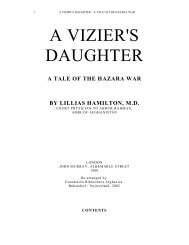The Inquiry into the History of the Hazara Mongols of ... - Hazara.net
The Inquiry into the History of the Hazara Mongols of ... - Hazara.net
The Inquiry into the History of the Hazara Mongols of ... - Hazara.net
Create successful ePaper yourself
Turn your PDF publications into a flip-book with our unique Google optimized e-Paper software.
HAZARA MONGOLS<br />
233<br />
Afghan Turkestan a few years later wrote <strong>of</strong> "<strong>Mongols</strong>" near Seripul who "pretend<br />
to have been settled <strong>the</strong>re by Ghengis Khan."6<br />
Schefer reported that "Les Hezareh fixes dans les environs de Deh Koundy<br />
se donnent comme les descendants d'un Arabe de la tribu de Qoreich."7 That<br />
<strong>the</strong> <strong>Hazara</strong>s should be <strong>of</strong> Arab descent is visibly incorrect. He may, however,<br />
be referring to seyyids, who trace <strong>the</strong>ir descent from Muhammed, and who<br />
are to be found scattered among <strong>the</strong> <strong>Hazara</strong>s.<br />
<strong>The</strong> most circumstantial tradition is that recorded by Elias8 as<br />
<strong>the</strong> view <strong>of</strong> <strong>the</strong> origin <strong>of</strong> his people which was held by a chief <strong>of</strong> <strong>the</strong> <strong>Hazara</strong> <strong>of</strong><br />
Turbat-i-Jam, who died in 1894 . . . [that] <strong>the</strong> present <strong>Hazara</strong> belonged to one <strong>of</strong><br />
<strong>the</strong> chief sections, or largest tribes, <strong>of</strong> <strong>the</strong> Moghuls. <strong>The</strong>y rebelled against Chingiz<br />
Khan, who ordered <strong>the</strong>m to be removed from Moghulistan to <strong>the</strong> Kohistan <strong>of</strong> Kabul.<br />
This order was being carried out, but Chingiz died just as <strong>the</strong> <strong>Hazara</strong> had crossed<br />
<strong>the</strong> Oxus. One <strong>of</strong> Chingiz's sons [descendant may be meant] moved part <strong>of</strong> <strong>the</strong>m<br />
to <strong>the</strong> Kohistan <strong>of</strong> Kabul; but some effected <strong>the</strong>ir escape and settled in Badghis.<br />
When one turs to historical records, <strong>the</strong>re seems little basis for <strong>the</strong> <strong>of</strong>ten<br />
reported statement that <strong>the</strong> <strong>Hazara</strong>s are descendants <strong>of</strong> military colonists planted<br />
in Afghanistan by Chinggis Khan at <strong>the</strong> beginning <strong>of</strong> <strong>the</strong> thirteenth century.9<br />
This statement may be traced back to <strong>the</strong> so-called Tarikh-i Wassaf, written by<br />
'Abdullah b. Fadlullah <strong>of</strong> Shiraz at <strong>the</strong> beginning <strong>of</strong> <strong>the</strong> fourteenth century.<br />
<strong>The</strong> Persian text is not available to this writer. D'Ohsson, drawing on Wassaf,<br />
wrote as follows: 10<br />
Tchinguiz-khan avait ordonne a ses quatre fils de fournir chacun un regiment<br />
de mille hommes pour former ce corps qui resterait cantonne dans les districts de<br />
Schebourgan, Talecan, Ali-Abad, Gaounk, Bamian et Ghaznin. Ces troupes firent<br />
des invasions dan la partie septentrionale de l'Inde.<br />
6 J. P. Ferrier, Caravan Journeys and Wanderings in Persia, Afghanistan, Turkistan,<br />
and Beloochistan (London, 1856), p. 231.<br />
7 Charles Schefer, "Khorassan" (extracted from Vol. 9 <strong>of</strong> <strong>the</strong> Fihris out Tewarikh <strong>of</strong><br />
Riza Qouly Khan, appearing as Appendix I to Histoire de l'Asie Centrale by Mir Abdoul<br />
Kerim Boukhary, in Publications de l'Ecole des Langues Orientales Vivantes, Paris, 1876),<br />
p. 265.<br />
8 Mirza Muhammad Haidar, Dughlat, Tarikh-i-Rashidi (London, 1898, appendix by<br />
N. Elias), p. 494d. This chief was probably a Western <strong>Hazara</strong>. <strong>The</strong> Kohistan <strong>of</strong> Kabul lies<br />
just north <strong>of</strong> Kabul, and just east <strong>of</strong> <strong>the</strong> <strong>Hazara</strong>jat, and is not now peopled by <strong>Hazara</strong>s.<br />
Badghis lies north <strong>of</strong> Herat.<br />
9 See H. W. Bellew, Afghanistan and <strong>the</strong> Afghans (London, 1879), p. 204; H. W.<br />
Bellew, <strong>The</strong> Races <strong>of</strong> Afghanistan (Calcutta, 1880), p. 114; Joseph Hackin, In Persia and<br />
Afghanistan with <strong>the</strong> Citroen Trans-Asiatic Expedition (<strong>The</strong> Geographical Journal, vol. 83,<br />
1934, pp. 353-363), p. 357; Sir Henry H. Howorth, <strong>History</strong> <strong>of</strong> <strong>the</strong> <strong>Mongols</strong> from <strong>the</strong> 9th<br />
to <strong>the</strong> 19th Century (4 vols., London, 1876-1888), vol. 3, p. 42.<br />
10 Baron C. d'Ohsson, Histoire des <strong>Mongols</strong>, depuis Tchinguiz-Khan jusqu'a Timour<br />
Bey ou Tamerlan (4 vols., Le Haye and Amsterdam, 1834-35), vol. 2, p. 280.



